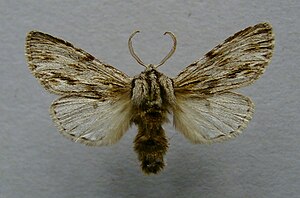Autumn wire-haired owl
| Autumn wire-haired owl | ||||||||||||
|---|---|---|---|---|---|---|---|---|---|---|---|---|

Autumn wire-haired owl ( Asteroscopus sphinx ) |
||||||||||||
| Systematics | ||||||||||||
|
||||||||||||
| Scientific name | ||||||||||||
| Asteroscopus sphinx | ||||||||||||
| ( Hufnagel , 1766) |
The autumn wire-haired owl ( Asteroscopus sphinx ), also called linden wire-haired owl or sphinx owl, is a butterfly ( moth ) from the owl butterfly family (Noctuidae).
features
butterfly
The wingspan is about 42 to 50 millimeters. The color of the forewings is quite variable, varying from gray-white and ash-gray to brown-gray or black-gray and is streaked with dark stripes. Faults are indistinct or not recognizable. Occasional white spots stand out on the wavy line. The hind wings are white to grayish white and have a pale brown point near the inner edge. The proboscis of the moths is stunted. The antennae of the males are combed, those of the females are not.
Egg, caterpillar and pupa
The egg is very flat, has a bulging rim and strong ribs. It is colored in different shades of gray. Young caterpillars are usually yellow-gray with black spots. Adult caterpillars have a green color, narrow, white dorsal and side dorsal lines, a yellow-white lateral stripe and white stigmas that are bordered in black. Typical of the caterpillar is the sphinx-like resting position with its head upright and bent back, which is also responsible for the name of the species. The red-brown doll is stocky and has two tips on a long, stick-shaped cremaster .
Similar species
- Asteroscopus syriaca (Warren, 1910). This species is usually smaller than sphinx , has more predominant gray tones on the forewings, which are also often slightly dusty blue, as well as more prominent transverse lines and rounder hind wings. Due to the great variability of colors, however, an unequivocal differentiation is only possible by means of a genital examination .
distribution and habitat
The species is widespread in Europe mainly in the central regions, north to England , Denmark and southern Sweden , east to Kaliningrad and Moscow , south to northern Spain , the southern edge of the Alps , central Italy and northern Greece . It is also found in Turkey and the Caucasus . The autumn wire-haired owl can be found in deciduous and mixed forests, but also in more open areas such as hedges, gardens, parks and avenues.
Way of life
The moths appear very late in the year and fly in October and November. They are nocturnal and love to fly to artificial light sources , but mostly the male moths. According to Haeger, the ratio of males to females in light is 40: 1. They are often found on street lamps and other light sources and are still active even at a temperature of 3 ° C. Because of the stunted proboscis, the moths do not eat any food. The caterpillars live in May and June, occasionally as early as April. They are polyphagous and feed on a wide variety of plants, of which only a selection is mentioned here:
- Linden species ( Tilia ),
- Willow species ( Salix ),
- Oak species ( Quercus ),
- Beech species ( Fagus ),
- Poplar species ( Populus ),
- Blackthorn ( Prunus spinosa ),
- Hazel species ( Corylus ),
- Fruit tree species
and other. Pupation takes place in the earth. The egg hibernates.
Danger
In Germany the species is widespread, in some areas numerous, although it is often overlooked because of the very late flight time. It is classified as not endangered on the Red List of Threatened Species .
swell
literature
- Günter Ebert (Hrsg.): The Butterflies of Baden-Württemberg Volume 6, Nachtfalter IV. Ulmer Verlag Stuttgart 1997 (Eulen (Noctuidae) 2nd part), ISBN 3-8001-3482-9
- Gábor Ronkay, Lázló Ronkay: Cuculliinae II. - Noctuidae Europaeae, Volume 7. , Sorø, 1995, ISBN 87-89430-04-2
- Walter Forster , Theodor A. Wohlfahrt : The butterflies of Central Europe. Volume 4: Owls. (Noctuidae). Franckh'sche Verlagshandlung, Stuttgart 1971, ISBN 3-440-03752-5 .
Individual evidence
- ↑ a b Gábor Ronkay, Lázló Ronkay: Cuculliinae II. - Noctuidae Europaeae, Volume 7. , Sorø, 1995, ISBN 87-89430-04-2
- ↑ Walter Forster, Theodor A. Wohlfahrt: The butterflies of Central Europe. Volume 4: Owls. (Noctuidae). Franckh'sche Verlagshandlung, Stuttgart 1971, ISBN 3-440-03752-5 .
- ↑ a b Günter Ebert (Ed.): The Butterflies of Baden-Württemberg Volume 6, Nachtfalter IV. Ulmer Verlag Stuttgart 1997 (Eulen (Noctuidae) 2nd part), ISBN 3-8001-3482-9
- ^ E. Haeger: 10 years house light capture (Macrolepidoptera). Journal for applied zoology, Duncker & Humblot publishing house, Berlin-Munich, 1956
- ↑ Federal Agency for Nature Conservation (Ed.): Red List of Endangered Animals in Germany. Landwirtschaftsverlag, Münster 1998, ISBN 3-89624-110-9
Web links
- www.lepiforum.de Taxonomy and photos
- www.nic.funet.fi dissemination
- www.schmetterlinge-deutschlands.de Occurrence and endangerment in Germany
- Asteroscopus sphinx at Fauna Europaea

